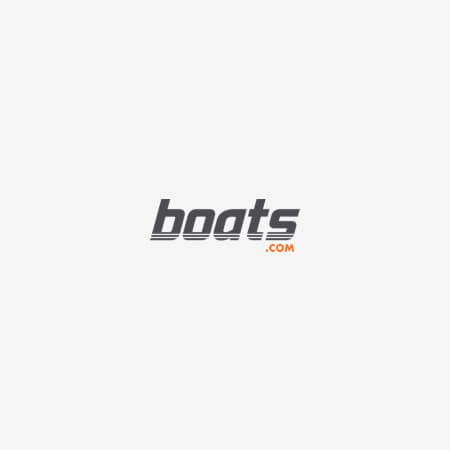Boatbuilder Portrait: Frauscher, Kings of Kaizen
With a new boat, new yard, and new production system, change is an important part of Frauscher's continuity.
In Hall 6 at the Düsseldorf Boat Show there’s a whiff of Hollywood: Azimut, Ferretti, Princess, Prestige. Big brands, big bucks. And smack in the thick of it is Frauscher, the Austrian builders, showing off their latest creation, the 1414 Demon. At 45 feet it is currently the largest model in their lineup, but one of the smaller ones in these surroundings. The Demon is designated to tap into new markets and venues, which means leaving lakes behind for the coast and clients who are looking for a sophisticated vehicle to enjoy a weekend on the water.

The 1414 Demon is poised to open up new markets for Frauscher. Photo © Dieter Loibner.
On the outside, the new yacht shows sporty lines and a dash of masculinity, while the interior is dominated by an avant-garde ambience and an unusual layout. Many functions are operated with push-button convenience, including the deployment of the passerelle, the bow anchor, or the cover of the dinghy garage. That’s a lot of technology, but opulence is compulsory in this league.
It’s not news that Frauscher knows how to build boats that are in demand; after all, this family enterprise has been in business for nearly 90 years. That proves a high level of survival skill, which is built on a passion for the boats themselves, plus quality of workmanship, business acumen, and a network of fans and friends who can, when called upon, offer important help. And not to forget the ability and willingness to innovate, adapting to new realities by trying fresh strategies without tossing the brand’s identity overboard. It’s about continual change and improvement, which is why Frauscher likes to grapple with methodical optimization. But more on that later.
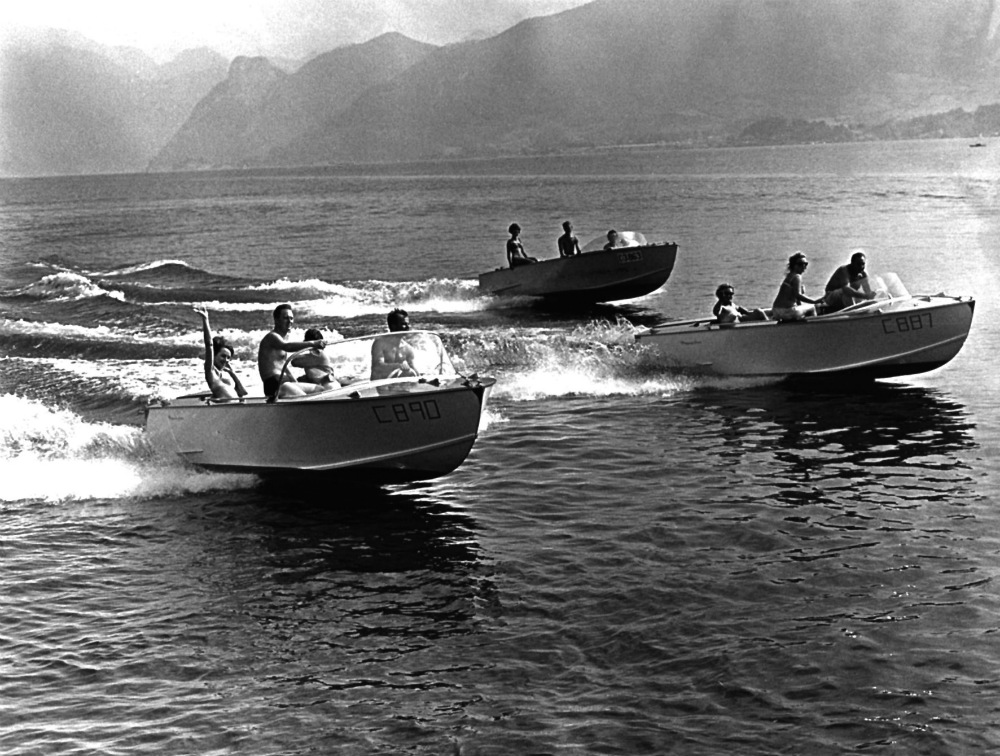
Frauscher in 1967: Three of their small inboard-powered boats heading across Lake Traunsee.
Grandpa Engelbert Frauscher made the start by moving from the rural Salzkammergut area to Vienna in the 1920s in search of better opportunities and to start his first boatbuilding shop on a side arm of the Danube River. After the facility was severely damaged by the bombing raids during World War II, he moved back to Gmunden, Austria, on Lake Traunsee, where he started his next boatbuilding operation. At first, he repaired sailboats for US military personnel, then part of the occupying forces, but soon he built small powerboats that helped lay the foundation for a firm that now is competing with yachting’s top brands.
At present, the business is managed by Stefan and Michael Frauscher, who represent the third generation and are in charge of sales and marketing, and production, respectively. At the show booth there's ample evidence that the rules of the bel étage have been internalized—dark suits for the staff, cozy armchairs for the sales chats, and cold bubbly for toasting closed deals. This is not about horsepower-porn but about style and emotion, as the company tagline helpfully points out.
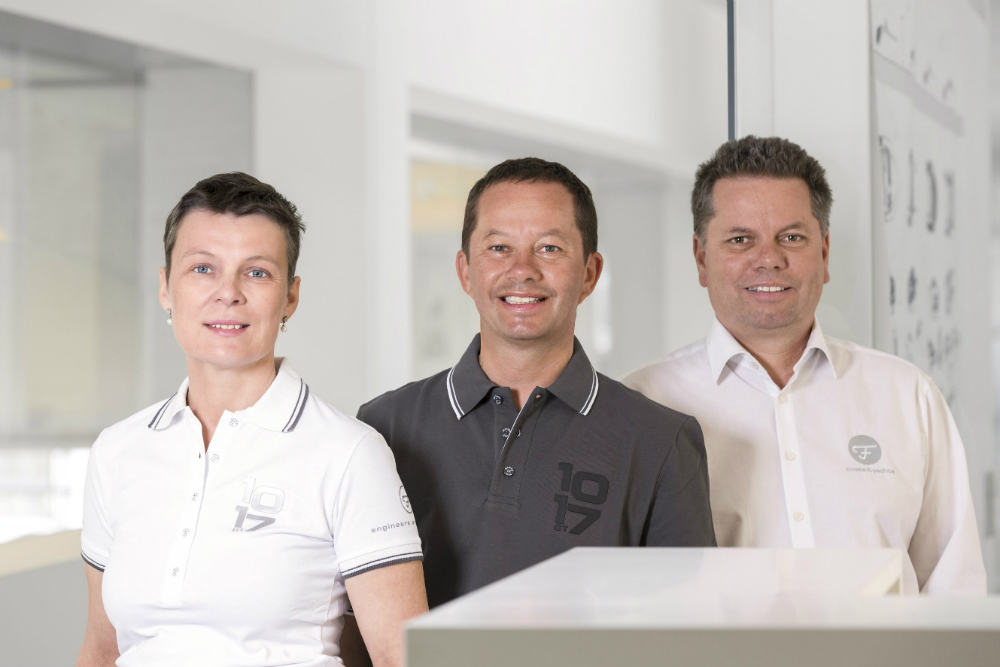
From left: Andrea Frauscher-Oberfrank, who is responsible for the Frauscher marina; Stefan and Michael Frauscher.
Yet there’s also a dash of humor, if it’s only watching the boss dart across the decks of his boats, colorful feather duster in hand, before attendees start flooding the show. But this seemingly trivial moment exemplifies the firm’s approach of paying big attention to small details. “The most important step for us is to be recognized as leaders in our segment in Europe,” says Stefan Frauscher. It’s an ambitious objective for the firm, which has already seen a rise in fortune since emerging from the last recession, generating annual revenues of approximately 10 million euros, mainly from sales of power and electric boats. Since 2012 Frauscher has been building these boats in a modern production facility in Ohlsdorf, near Gmunden, while also operating a sales subsidiary in Mallorca and maintaining an international presence through dealerships in 14 countries, including the USA.
Frauscher styling has that pinch of eroticism that’s inherent to sports cars and especially appeals to men who are used to making decisions, who are comfortable in the spotlight, and whose toys are symbols of status. Politicians, actors, captains of industry, artists, and prominent athletes are at the helms of Frauscher boats. Officially the company does not disclose names, but an Austrian news magazine reported that the King of Morocco and software tycoon Larry Ellison are on the roster of demanding customers.
Looks alone certainly wouldn’t suffice—the demand is also for refined engineering and construction, for which Frauscher has a ton of talent available: Yacht designer Harry Miesbauer, for example, is in charge of the hulls’ underwater shape and hydrodynamics. He previously worked for Wally, Brenta, and Frers, where he was known as a specialist in luxury sailing yachts. He grew up in close proximity to Lake Traunsee and attended the Frauscher sailing school as a youth, which is how the family came to know him. “One day Michael called me and suggested I design a boat for him,” Miesbauer remembers. A powerboat. “A powerboat? It got me a little scared,” he laughs. But he calculated everything as if he were designing a sailing yacht, meaning he was a stickler for light weight, something that doesn’t hurt powerboats either.

A rendering of the 1414 Demon's side view shows the stepped hull shape.
Miesbauer, in turn, knew Gerald Kiska, lead designer of KTM, an Austrian company that makes dirt bikes. Kiska runs his own industrial design agency in Salzburg and delivers the lines and the computer data for the master plugs of Frauscher’s boats. Then there’s Thomas Gerzer, who further refines design, deals with handling and ”nautical necessities,” and decides what can and cannot be implemented in the production.
Reviewers seem pleased with the results: “Even in rough water and at pace the deck stays dry, a long waterline takes care of directional stability, and the deep V-hull dips into the waves gently,” is how one critic described the Frauscher 858 Fantom in an ocean test.
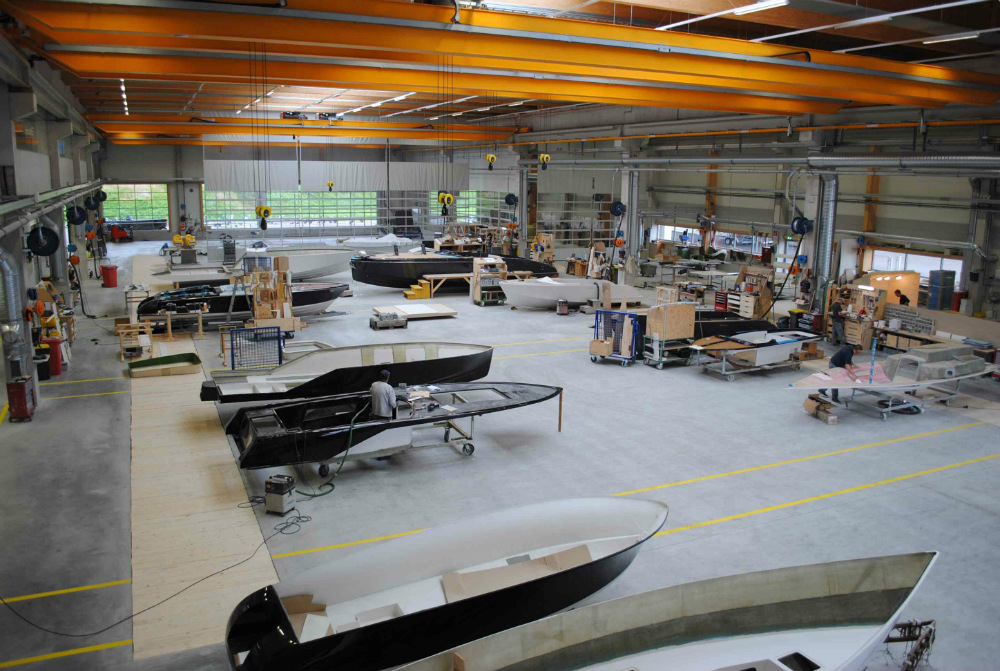
Frauscher's new production facility in Austria.
A builder that employs just 45 people, yet produces 60 to 80 vessels a year and holds its own in the premium market, is a builder whose owners have learned to manage processes efficiently. The current approach commenced after Stefan and Michael took the reins from father Hans and Uncle Ernst (Meanwhile, their cousin Andrea Frauscher-Oberfrank manages the marina as a separate business entity.)
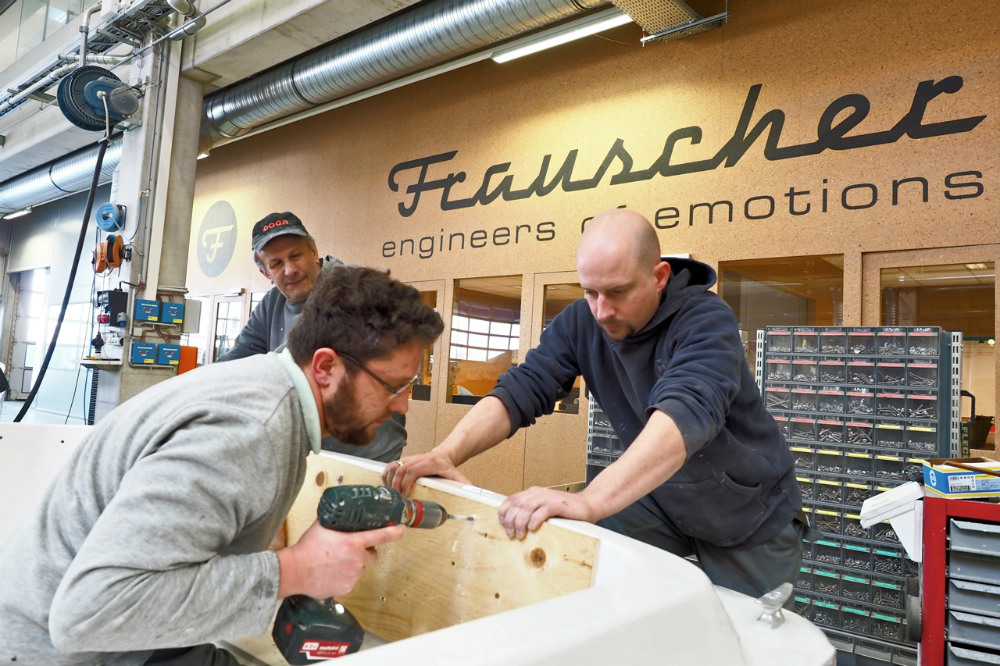
Three workers prepare an aft bench for custom upholstery. Photo © Dieter Loibner.
“The old way did not offer a path forward,” Michael explains. They wanted more, but first they had to learn how to do with less. The key process would be lean manufacturing to reduce waste and inefficiencies. That included the Kaizen principle, which that has been implemented in industrial enterprises to attain continual improvement, and the 5 Whys, a method used in quality management. At Frauscher it’s also used to keep developing existing products: A team representing sales, purchasing, production, and design goes over a boat and asks what can be done smarter, better, and more cost effectively.
“It started in 2010, in the midst of the recession, and was implemented after a trial period in 2012,” says Michael Frauscher, remembering the beginnings of this risky and stressful endeavor. There were differences in opinion and even shouting matches on occasion, but before long the team approach made its impact. The network of Frauscher supporters also came through. Armin Burger, an executive with two large grocery chains, and Andreas Asamer, a local entrepreneur in the construction industry, joined as investors, and each received 12.5 percent of the company shares, which the Frauscher family bought back in 2014. Also valuable was the advice of car czar Ferdinand Piëch (Porsche, Volkswagen), who paid a visit to the yard and found, according to Stefan Frauscher, that the automotive industry could learn something about product customization from boatbuilders. Porsche’s former PR-chief Anton Hunger also advised Frauscher on matters of advertising.
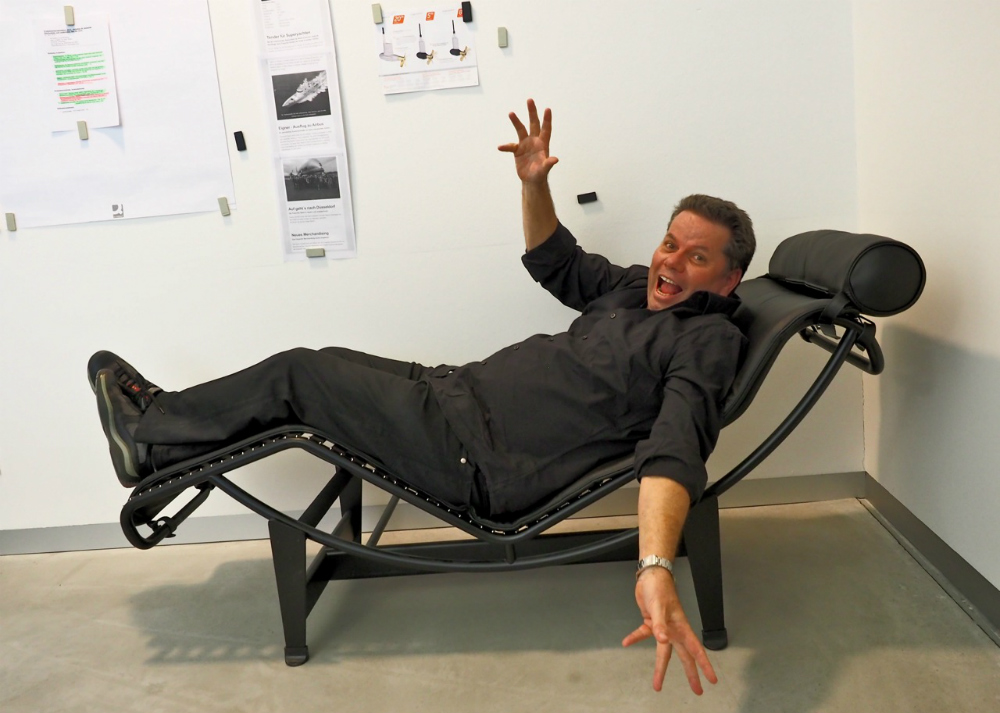
Michael Frauscher waking up from a siesta in his office, right underneath the Kaizen goals that are posted on the wall. Photo © Dieter Loibner.
“Marketing is something that happens to us,” jokes Michael, but Frauscher’s ad campaigns are anything but happenstance. Boasting a mix of lifestyle, adrenaline, and product placement, they specifically address customers who love luxury but don’t own boats yet. Two examples are the promotion video for the 1017 GT featuring stunt pilot Hannes Arch, and the Heineken advertising spot with James Bond character Daniel Craig in the leading role, eluding evil-doers who are in hot pursuit on two 747 Mirages.
But back to the lean manufacturing. The initial visit of the consultants from Porsche offered a lesson with lasting impact: “If a consultant that charges several thousand euros per day first has to clean up his desk in our office, this was going turn into an expensive experiment,” Michael recounts. “So at the next visit, everything was squeaky clean.”
Since then tidiness has been the company’s practiced principle, as is evident on a factory visit. From the front desk to the warehouse, the shop floor and the men’s locker room, everything is scrupulously clean. Just as in high-tech companies, the offices are kept simple and functional with concrete floors and glass walls. This points to flat hierarchies, transparency, and an effective workflow. Lean also applies to the company’s executive floor. It’s essentials and necessities.
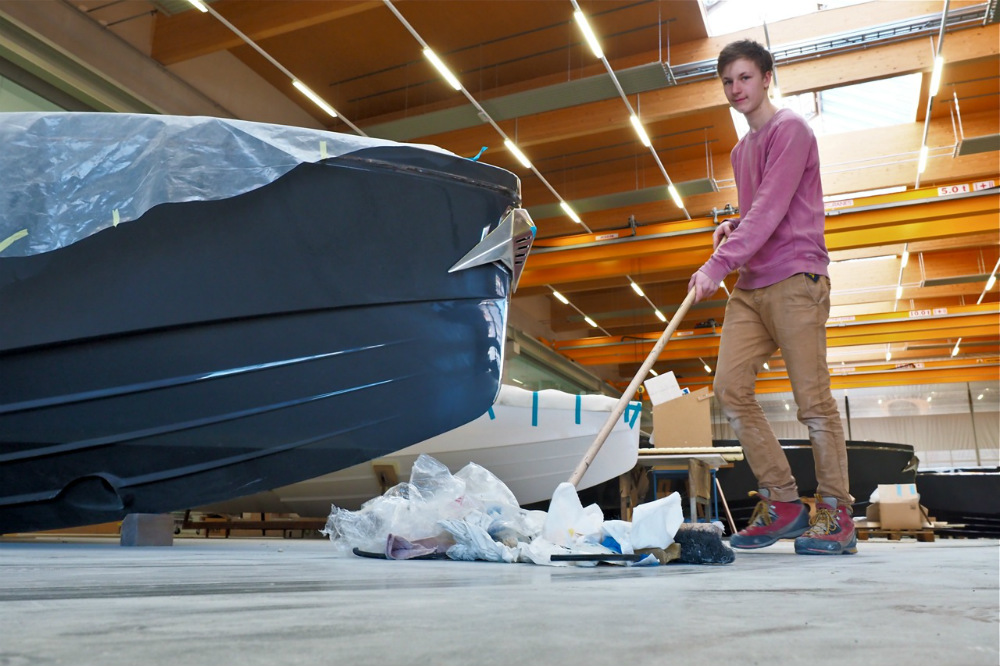
Lean and clean: Frauscher's mantra is followed at all turns of the production process. Photo © Dieter Loibner.
The warehouse, which is level with the shop, is painstakingly well-organized and surprisingly small. The number of suppliers has been gradually cut in half, with several in the immediate vicinity. They deliver on time and on demand, which helped cut Frauscher’s warehousing cost by 80 percent.
The lineup was streamlined to five powerboat and four electric boat models. The hulls are exclusively laminated for Frauscher by an Italian outfit that specializes in fiberglass construction. Deck, interior, fit-out, and systems are all done at Frauscher’s Ohlsdorf facility. Some older models, plus sailboats, are only available upon special request. And that’s a pity really, because sailing yachts have a great tradition at Frauscher yard: Grandpa’s O-dinghies were used in the 1936 Olympics in Germany, and were later followed by Dragons, Zugvogel, Dyas, Trias (all keelboats for lake sailing) and the pretty h26 daysailer. But the clear bestseller was the H-Boat, a Scandinavian design of which the company built more than 700 units. Fun fact: Hans and Stefan each won the H-Boat Worlds, 20 years apart.
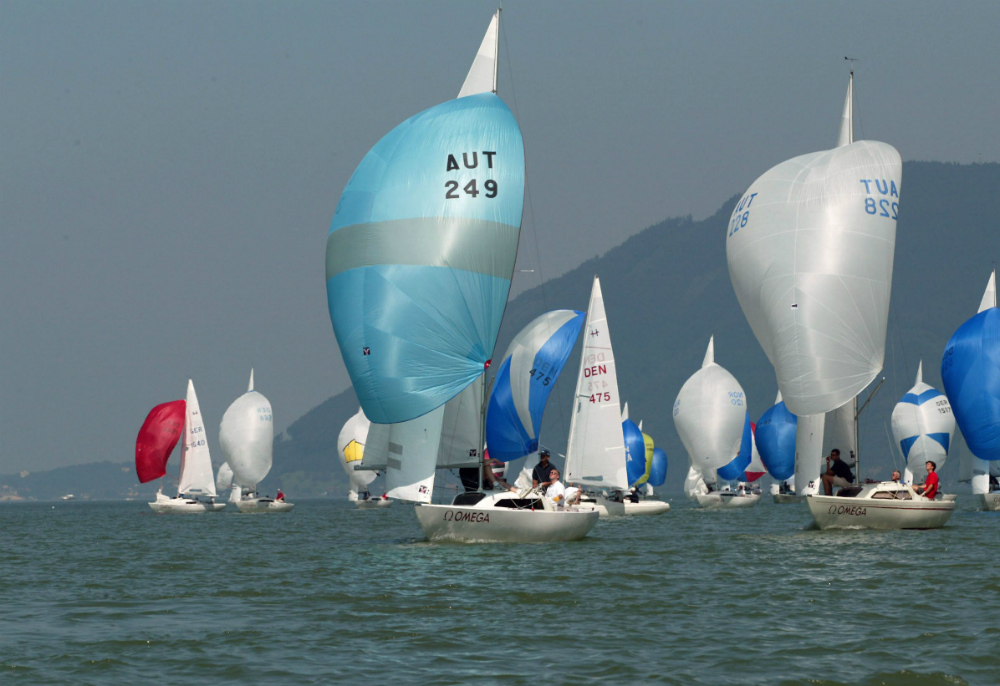
The famous Scandinavian H-Boat was once a best-seller. Father Hans and son Stefan each won the world championship in this class.
Reducing sailboat production was one of the changes dictated by the market, the Frauschers say. Today about 60 percent of the current production is dedicated to engine-driven powerboats, the rest to boats with electric propulsion. The latter are in high demand because they’re exempt from operating restrictions on boats with combustion engines that apply to freshwater lakes in central Europe. The first such boats were built from wood in the 1950s; their fiberglass successors remain popular with rental businesses and have helped generations of casual captains potter across a lake without an operating license.
But these electric-powered boats have changed substantially, too. Propulsion systems and batteries have become much more powerful and sophisticated (e.g.Torqeedo’s 50-kW Deep Blue system) while computers manage energy consumption more efficiently. Those boats are much faster, but also more expensive, and do require a license for the operator.
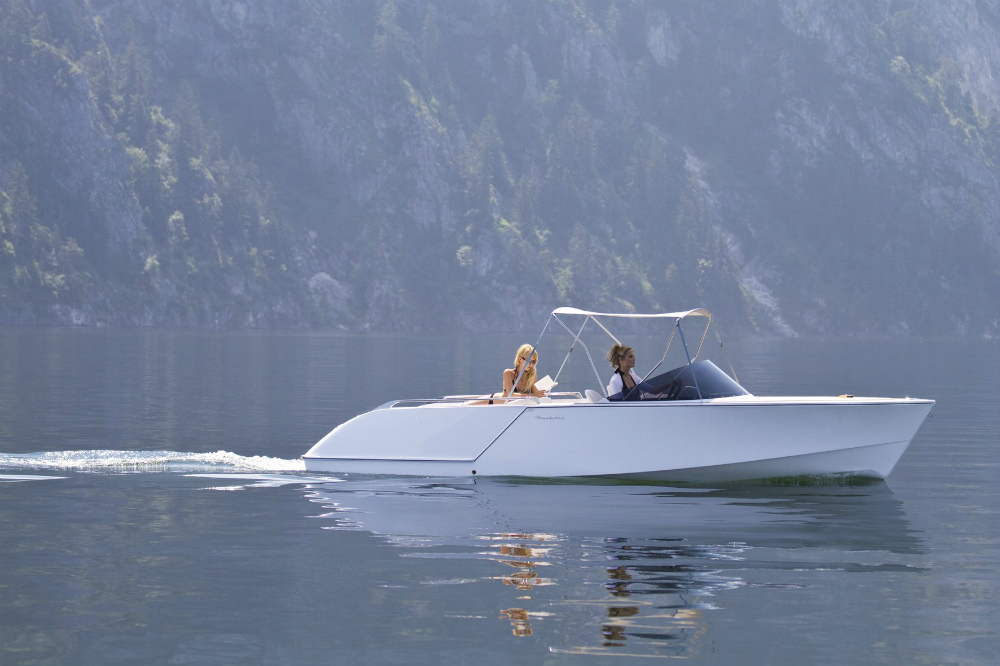
The Frauscher 650 Alassio electric boat.
Stricter emission rules for boat engines as part of climate protection would not put Frauscher on the spot, because they already have boats on the water equipped with Steyr’s diesel-electric hybrid propulsion. They also received EU financing a few years ago for the development of a prototype electric boat powered by a hydrogen fuel cell.
“Power boats won’t be scrapped any time soon,” notes Michael Frauscher, “but if new restrictions get imposed, we’re ready with our experience and competence in alternative propulsion technologies.”
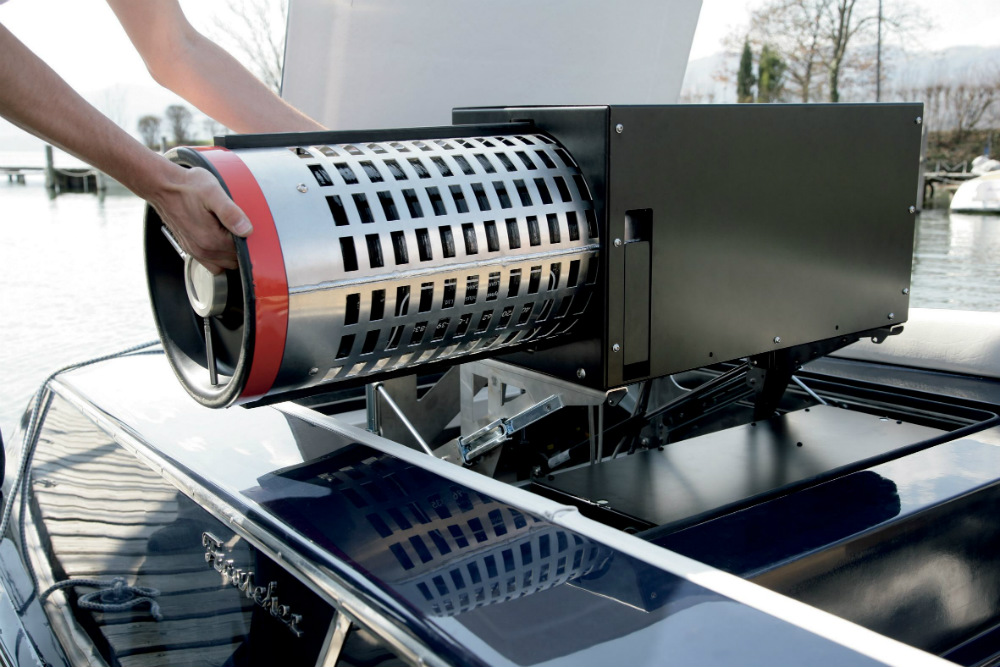
This exchangeable hydrogen tank on a Frauscher electric boat is fitted with a fuel cell.
All this is a far cry from the business that father Hans and Uncle Ernst inherited from Grandpa Engelbert. They didn’t have to worry about lean manufacturing, the 5 Whys, Kaizen, or fuel cells. But those were different times with different challenges and perspectives. It’s fortunate, Father Hans says in a company video, that the kids stepped up to continue the family legacy.
Retiring can be a tough challenge for anyone accustomed to running a business, but done right and on time it creates the space and the opportunity for the younger generation to come up with fresh ideas and to make any necessary course corrections.
It would appear that the new approach is working out well for the Frauschers. The show booth in Düsseldorf, surrounded by megayachts, is but one symbol.








